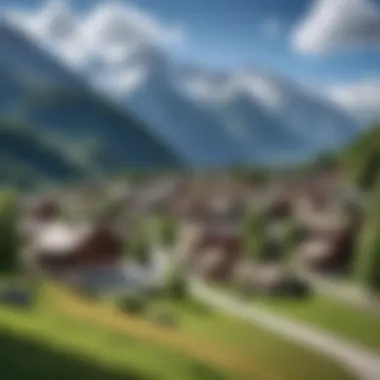Exploring the Geographical Wonders of the French Alps


Intro
The French Alps are not just a geographic marvel but also a prominent cultural icon. They stretch across southeastern France, forming a breathtaking boundary with Italy and Switzerland. Their distinct location marks them as a pivotal area for both nature enthusiasts and tourists alike. The purpose of this discussion is to paint a comprehensive picture of the Alps' geographical positioning, while exploring nearby cities, mountain ranges, and attractions that set them apart from other regions in France.
Popular Destinations
Unique Locations for Exotic Travel
The French Alps host a variety of unique destinations that cater to different types of travelers. Some notable locations include:
- Chamonix-Mont-Blanc: Known for its stunning landscapes and climbing routes. It is famous not only for skiing but also for its vibrant year-round activities.
- Annecy: Often referred to as the "Venice of the Alps," this city features picturesque canals and stunning views of the lake, making it a hit among those seeking both relaxation and adventure.
- Grenoble: This city benefits from proximity to several ski resorts. It also serves as a gateway for those interested in hiking and exploring the surrounding natural parks.
Each of these destinations offers a unique experience that showcases the richness of the Alps.
Comfortable Places for Family Vacations
Families looking for a memorable getaway will find several spots that cater to their needs:
- Les Deux Alpes: Particularly family-friendly with a selection of ski schools for children, ensuring that everyone can enjoy the slopes safely.
- Méribel: This resort provides various activities beyond skiing, including snowshoeing and village events, which appeal to all ages.
- La Clusaz: Offers a quaint village atmosphere along with amenities suitable for families. The region features gentle slopes ideal for beginners.
These locations promote a family-friendly atmosphere, making it easier to enjoy time together in the Alps.
Preparing for Your Journey
Tips for Choosing a Route
When planning a trip to the French Alps, determining the right route is essential. Here are a few tips:
- Research Public Transport: The Alps are accessible via several train stations and bus routes, especially around major hubs like Annecy and Geneva.
- Consider Time of Year: Your preferred activities may dictate the best time to visit. Winter is ideal for skiing, while summer showcases hiking and biking.
- Safety in Mind: Some mountain passes can be tricky in winter. Always check weather conditions.
How to Pack: Useful Tips
Preparing your suitcase can shape your experience:
- Layering: Weather in the Alps can fluctuate. Bring layers to be prepared for sudden changes.
- Essentials: Pack sunscreen, even in winter, as sunlight reflects on snow.
- Footwear: Ensure you have proper walking or hiking boots. Comfort is key when exploring trails.
By taking these factors into account, you can ensure a smooth and enjoyable visit to the French Alps.
"The location of the Alps not only shapes the natural beauty of France but also influences its cultural and recreational offerings."
Prelude to the French Alps
The French Alps hold a notable position within the broader context of Alpine geography and culture. This section aims to underscore the significance of the French Alps, revealing their geographical dominance, cultural richness, and historical backdrop. Understanding the French Alps is paramount for travelers, scholars, and enthusiasts who seek a deeper connection to the region.
The Alps extend across several countries in Europe, but the French segment offers a diverse array of attractions and experiences. The location plays a critical role in influencing weather patterns, biodiversity, and tourism opportunities. Accessibility to various amenities and natural wonders is another aspect that enhances the prominence of this mountain range.
The French Alps not only attract adventure seekers but also those interested in history and local traditions. Their impact on French culture and heritage cannot be overstated. The interplay between the natural landscape and human activity results in unique cultural expressions, enhancing the allure for visitors. The following subsections will explore the overview of the Alps and their historical significance, providing a comprehensive foundation before delving into more specific aspects of the region.
Overview of the Alps
The Alps represent one of the most extensive mountain ranges in Europe, stretching approximately 1,200 kilometers from the Mediterranean Sea to the Pannonian Plain. Within this vast corridor, the French Alps extend through southeastern France, creating some of the continent's most picturesque landscapes and thriving ecosystems.
This region comprises several notable peaks, including Mont Blanc, which stands as the highest summit in the Alps. The rugged terrain encompasses deep valleys, crystal-clear lakes, and vast forests, offering a variety of settings for both exploration and relaxation. Additionally, various rivers, such as the Rhône and the Isère, originate from the Alps, playing a crucial role in the regional climate and agricultural practices.
The geographical composition serves not only as a natural wonder but also as a functional infrastructure, connecting cities and towns through established hiking trails, roads, and ski slopes. The diverse topography supports a mix of activities, ranging from skiing in winter to hiking in summer. With such attributes, the overview of the Alps sets the stage for understanding their multi-faceted importance to both the environment and the people.
Historical Significance
Historically, the Alps have served as a strategic barrier and means of connection among various civilizations. They have witnessed migrations and invasions, shaping the cultural landscape of the region. This mountainous expanse served as a natural shield, influencing military campaigns and trade routes throughout history.
The significance of the French Alps also extends into art and literature. Numerous artists and writers have drawn inspiration from their majestic scenery. Mountain climbing and skiing have become integral parts of the culture, starting from the 19th century and evolving into world-class recreational activities.
Moreover, the region’s towns and villages preserve historical architecture that reflects unique regional styles and traditions that date back centuries. For instance, Chamonix, one of the oldest ski resorts, has transformed itself while still preserving its historical essence. Many of these locations highlight the resilience of communities that have adapted to the challenging Alpine environment.
"The mountains offer us not only a view into nature but also a glimpse into our past."


The historical narratives intertwined with the French Alps contribute significantly to their allure. The blend of natural beauty and human history enriches the overall experience for those who visit or study this remarkable region.
Geographical Context
The geographical context of the French Alps is crucial in understanding not only the region itself but also its importance in the broader European landscape. This section will discuss the physical placement of the Alps, aspects that influence accessibility, and how these elements contribute to tourism and cultural exchange.
Location within Europe
The French Alps are positioned in the southeastern part of France. They are part of the larger Alpine mountain range that extends through several European countries. Their location makes the French Alps accessible from various European hubs, which attracts tourists and lovers of nature alike. This significant positioning means that they hold a central role in winter and summer tourism.
The Alps are considered as one of the major mountain ranges in Europe, extending from the Mediterranean coast to the Austrian border. Notably, the French segment hosts some of the highest peaks, including Mont Blanc, which is the tallest mountain in Western Europe. This eminence enhances its appeal as a destination for those seeking adventure, while also providing breathtaking landscapes. The geographical context offers insights into how the natural features influence the climate, ecosystems, and overall attractiveness of the region for both leisure and sport activities.
Borders and Adjacent Countries
The French Alps share borders with three significant countries: Switzerland, Italy, and Austria. Each of these neighboring nations contributes distinctly to the geographical and cultural fabric of the Alps.
Switzerland
Switzerland is one of the notable neighbors of the French Alps. This country is renowned for its pristine landscapes and luxurious ski resorts. The Swiss Alps offer advanced skiing infrastructure and attract a wealthy clientele. The cultural link between France and Switzerland enriches the experience for visitors. The culinary features and traditions in this region often have shared elements. However, there can be a contrast in the pricing of accommodations and services, prompting travelers to compare their options closely.
Italy
Italy, lying to the southeast of the French Alps, brings a unique charm to the region. Italian Alps are famous for their picturesque villages, stunning vistas, and rich culinary traditions. The proximity to Italy allows visitors to experience diverse cultural elements in a single trip, such as Italian wine, cheese, and pasta. However, linguistic barriers might exist, as parts of the populations in the bordering areas may not be fluent in French. This can influence travelers' interactions and accessing services.
Austrian border
The Austrian border also provides a striking geographical context. The Alps here are known for dramatic scenery and well-maintained trails. This section is popular among hikers and nature enthusiasts. One key characteristic of the Austrian Alps is their relatively lower crowd levels compared to other regions. This can be advantageous for tourists looking for peaceful experiences. Nevertheless, the distance from major urban centers may pose logistical challenges for visitors relying on public transport.
Overall, the geographical context of the French Alps reveals how they are influenced by their borders with Switzerland, Italy, and Austria. Each country adds a layer of complexity and appeal to the region, showcasing a blend of natural beauty and cultural richness.
Key Regions of the French Alps
The French Alps stretch across a rich landscape that is not only breathtaking but also practical in terms of access and attractions. Understanding the key regions of the French Alps provides insight into both natural beauty and cultural significance. These regions serve as gateways to the majestic mountain ranges, offering unique experiences for tourists and locals alike. Each area has its distinct charm and features that attract visitors, whether for outdoor activities or cultural interactions.
Auvergne-Rhône-Alpes
The Auvergne-Rhône-Alpes region is one of the most prominent in the French Alps. It encompasses major alpine cities such as Lyon and Grenoble, making it a significant hub for tourism and economy. The varied geography includes towering peaks, deep valleys, and lakes, forming a diverse ecosystem that is home to flora and fauna unique to the Alps.
In terms of tourism, this region boasts several renowned ski resorts like Les Deux Alpes and Alpe d'Huez, which offer extensive facilities for winter sports enthusiasts. Beyond skiing, the area provides numerous hiking trails during the summer months. Visitors can explore natural parks such as the Parc National de la Vanoise, where the beauty of the mountains is paired with opportunities for adventure.
Furthermore, Auvergne-Rhône-Alpes is rich in culture. Local festivals celebrate traditions and gastronomy, highlighting dishes such as fondue and raclette. The blend of nature, accessibility, and culture makes this region a focal point for exploring the French Alps.
Provence-Alpes-Côte d'Azur
Provence-Alpes-Côte d'Azur stands out as another vital region within the French Alps. This area is renowned for its combination of mountain and Mediterranean influences. While it includes the dazzling coastline of the Cote d'Azur, it also harbors significant alpine territory which offers a diverse range of outdoor activities.
Tourists flock to this region for several reasons. Areas like Briançon and Embrun provide excellent skiing opportunities in winter, while the summer months attract hikers and bikers looking to explore trails like the GR5. The beautiful scenery here includes turquoise lakes and lush valleys framed by majestic peaks.
Culturally, Provence-Alpes-Côte d'Azur is steeped in history, with charming villages such as Èze and Moustiers-Sainte-Marie. The local gastronomy reflects Mediterranean influences, with emphasis on fresh produce and traditional recipes. Festivals often occur throughout the year, celebrating local heritage and arts.
In summary, Provence-Alpes-Côte d'Azur allows visitors to enjoy both mountain ecology and cultural vibrancy, making it an essential part of any exploration of the French Alps.
Major Cities Located Near the Alps
The cities that lie in close proximity to the French Alps play a major role in the attraction and experience of the region. These urban centers serve not only as gateways to the mountains but also as crucial hubs for culture, transportation, and tourism. The location of these cities impacts the accessibility to the Alps and the variety of activities available to visitors. It fosters a unique blend of urban and natural environments, making them essential for every traveler’s itinerary.
Grenoble
Grenoble is often referred to as the "Capital of the Alps." It holds significant importance due to its strategic position at the foot of the French Alps, making it a prime starting point for both winter sports and summer hiking. Surrounded by stunning mountain ranges, its picturesque landscapes enhance the city’s charm.
Grenoble has a rich historical background, with its roots going back to Roman times. This history is visible in its architecture, such as the Bastille fortress, which overlooks the city. The transportation network in Grenoble is quite robust, featuring both train and bus lines that connect travelers to various points in the Alps.
Additionally, the city has a vibrant cultural scene, boasting numerous museums, theaters, and universities. Economic activities are diverse, bridging technology, education, and tourism, which is vital for local growth and sustainability.
Chamonix


Chamonix-Mont-Blanc is perhaps one of the most famous alpine towns in the world. Known primarily for its ski resorts and access to Mont Blanc, Chamonix attracts thousands of tourists each year. The city’s elevation and scenic beauty make it an ideal location for outdoor activities, including skiing, climbing, and hiking.
Chamonix also serves as an important cultural center. It hosts various events throughout the year, including the renowned Ultra-Trail du Mont-Blanc, which draws athletes and audiences globally. The city has a unique mix of luxury and rustic charm, evident in its hotels, dining options, and boutiques.
The proximity to major ski areas and the access to stunning natural landscapes make Chamonix a significant location for both winter and summer tourism. The public transportation system here is well organized, allowing easy access to surrounding mountains and trails.
Annecy
Annecy, known as the "Venice of the Alps," is famous for its picturesque canals and stunning lake. Its location along Lake Annecy, surrounded by mountains, contributes to its reputation as a beautiful city to visit. This town combines a rich historical context with vibrant contemporary life. Historical buildings, such as Château d'Annecy, reflect the area’s deep-rooted legacy.
This city is also well positioned for those seeking adventure as well as relaxation. The surrounding areas offer numerous recreational opportunities, from biking and hiking in summer to skiing in winter. The blend of cultural experiences and beautiful outdoor settings makes Annecy a sought-after destination.
The city is accessible via various means of transportation, including trains and buses. This connectivity enhances its attractiveness not just for tourists but also for families and individuals residing nearby.
Navigational Aspects
Navigational aspects are crucial for understanding how visitors can access and explore the French Alps. With their breathtaking views and diverse outdoor activities, the Alps attract a multitude of travelers. To fully appreciate this region, it is essential to know the routes and transportation modes available. The flow of tourism depends significantly on ease of access.
Access Routes
The French Alps are well-connected by a network of roads and highways. Major access routes include the A40, which links Geneva to Chamonix, and the A41, connecting Annecy to Chambéry. These routes offer scenic views and lead directly to many popular destinations.
Additionally, visitors coming from Switzerland can use the Route Blanche, which is a picturesque drive along the edge of the Alps.
For those traveling by car, several mountain passes, like the Col de la Forclaz and Col du Galibier, provide stunning vistas. However, during winter months, some of these passes may close due to snow, making it important for travelers to check conditions before heading out.
Public Transportation
Public transportation plays a significant role in navigating the French Alps. Train services from major French cities provide convenient access to regions like Grenoble, Annecy, and Albertville.
The SNCF trains are efficient for longer distances, while local buses fill in gaps between towns and ski resorts. Some ski areas, like Serre Chevalier, even offer shuttle services for skiers.
Using public transport not only reduces carbon footprint but also allows travelers to enjoy the magnificent landscape without the stress of driving. The availability of well-timed connections benefits both tourists and locals alike.
"Understanding the navigational aspects of the French Alps enhances the overall experience for any traveler."
Overall, knowing about access routes and public transport options creates a more comprehensive understanding of the French Alps' location. This awareness enriches the travel experience by facilitating smooth transitions from one breathtaking site to another.
Tourism in the French Alps
Tourism plays a vital role in the economy and culture of the French Alps. The region attracts millions of visitors annually, drawn by its breathtaking landscapes, outdoor activities, and captivating local culture. Tourists come for various reasons: skiing in the winter, hiking in the summer, and exploring charming alpine villages year-round. Understanding tourism in this area is essential for recognizing its significance to not only the local communities but also to France as a whole. It fosters a connection between visitors and the natural environment, as well as the rich traditions that define the Alps.
Key Attractions
Ski Resorts
Ski resorts in the French Alps are among the most defined attractions for tourists. Renowned for their reliable snow and diverse courses, places like Chamonix and Val d'Isère highlight the region's appeal. The resorts cater to various skill levels, making them popular among both novices and experienced skiers. The variety in ski terrain allows each visitor to enjoy a tailored experience. One unique feature is the expansive network of lifts which increases accessibility to high-altitude slopes.
However, overcrowding during peak seasons can diminish the skiing experience. Yet, advanced facilities and quality instruction help mitigate these issues, ensuring that visitors still have a rewarding experience.
Hiking Trails
Hiking trails are another draw for tourists who prefer warmer climates. The French Alps offer a plethora of trails that vary in difficulty and scenic views. This diversity attracts families and solo adventurers alike. The key characteristic of the trails is the stunning alpine scenery combined with the peaceful atmosphere.
Hiking trails often connect to cultural sites, enabling hikers to discover history while exploring nature. Some trails can be quite challenging, which may deter certain groups, but many options cater to all fitness levels. Overall, they encourage outdoor activities and foster a deeper appreciation for the natural environment.
Cultural Sites
Cultural sites serve as a bridge between tourism and local heritage. The French Alps are home to numerous historic villages and landmarks. These include ancient monasteries and fortified towns that showcase unique architectural styles. The key characteristic of cultural sites in this region is their ability to narrate the historical significance of the area.
For visitors, exploring these sites provides insight into the local traditions and lifestyle. They also experience art, cuisine, and community events, which enhance their understanding of the Alps beyond just its landscapes. Challenges do exist, such as maintaining the integrity of these sites while accommodating increasing numbers of tourists.
Seasonal Tourism Trends
The French Alps have distinct seasonal tourism trends that affect what visitors seek in each period.


- Winter: This season primarily focuses on skiing and snowboarding, with ski resorts seeing peak visitation. The Christmas period is also popular, attracting families looking for festive experiences.
- Summer: Hiking and mountain biking come to the forefront, as warmer temperatures allow for favorable outdoor activities. Many travelers visit to enjoy nature and participate in various festivals.
- Shoulder Seasons: Spring and autumn see fewer tourists, but these periods can be appealing due to milder climates and less crowded attractions. Local events and cultural festivals often attract visitors seeking a more authentic experience.
This cyclical tourism model highlights the need for sustainable practices to preserve the environment while maintaining economic benefits. The balance between local needs and tourist engagement is a key factor in shaping the future of tourism in the French Alps.
The French Alps stand as a prime example of the interplay between natural beauty and cultural depth, making them a top destination for diverse travelers.
By understanding the attractions and trends, visitors can maximize their experiences in this iconic region.
Cultural Significance of the Alps
The French Alps hold a significant position in the cultural landscape of France and beyond. Their importance extends beyond mere geography; they embody a rich tapestry of tradition, history, and community. The Alps have shaped the local identity in various ways, influencing art, music, and social practices. Understanding these cultural dimensions enhances appreciation for the location's deeper meanings and the lives intertwined with its majestic landscapes.
Local traditions are remarkably vibrant and vary from village to village. Festivals celebrate seasons, historical events, and agricultural milestones. For instance, the Fête de la Transhumance involves herders guiding their livestock to higher pastures, a practice that fosters community spirit and preserves age-old customs. Traditional Alpine music, characterized by its use of the accordion and local folklore themes, plays a vital role in community gatherings. These traditions provide not only entertainment but also a sense of belonging, connecting people to their ancestors and the land they inhabit.
Local Traditions
The deep-rooted customs of the French Alps reflect the region's unique heritage. Many villages maintain their individualized practices, which highlight the importance of family and community values. Towns continue to organize local markets, where artisans showcase crafts and produce alike. The charm of these markets lies in their ability to bring people together, offering a space for social interaction and economic exchange.
Through significant events like the winter festivities, locals create a welcoming atmosphere that attracts visitors and fosters cultural exchange. These celebrations feature regional music, dances, and traditional costumes that immerse anyone present into the Alpine culture. In addition, folk tales and legends often told around bonfires further enrich the cultural narrative, offering insights into the people’s values and beliefs.
Gastronomy and Craftsmanship
Culinary traditions in the French Alps deserve special mention within the cultural context. The abundance of fresh, local produce influences the cuisine. Signature dishes such as fondue savoyarde and raclette showcase the region’s dairy heritage. These meals not only nourish but also bring families together around the table, reinforcing social bonds.
Craftsmanship is another vital aspect of the cultural fabric of the Alps. Artisans create unique woodworks, textiles, and pottery using traditional techniques passed through generations. The meticulous art of crafting these products reflects the characteristics of the landscape, creating items that resonate with the natural surroundings.
The cultural significance of the Alps extends beyond their physical presence; they are a living aspect of identity for the communities that inhabit them.
Overall, the cultural significance of the French Alps is a blend of local traditions and craftsmanship, all of which intertwine to create a multifaceted identity for the region. Recognizing this depth allows travelers to engage more meaningfully with the culture and people, making their experience richer and more rewarding.
Environmental Considerations
The French Alps are not only an awe-inspiring geographical feature but also a crucial area for environmental considerations. As one of the most significant mountain ranges in Europe, the Alps present unique ecological systems, which necessitate careful management and conservation efforts. The environmental aspects of the French Alps play a vital role in larger discussions surrounding climate change, biodiversity, and sustainable tourism.
Conservation Efforts
Conservation efforts in the French Alps focus on protecting rare species of flora and fauna that thrive in this mountainous region. The establishment of national parks, such as Vanoise National Park, ensures that these natural habitats receive proper protection from urban development and industrial activities. These protected areas help to preserve fragile ecosystems, which are sensitive to climate fluctuations.
Local authorities and organizations work tirelessly to implement various conservation programs. For instance, initiatives aimed at reforestation not only support biodiversity but also mitigate the effects of soil erosion. Additionally, efforts to regulate hunting and fishing in certain zones aim to balance human activities with the needs of wildlife.
A significant aspect of the conservation narrative involves educating visitors about the local environment. Many guided tours emphasize the importance of preserving delicate habitats. This education helps visitors recognize their role in maintaining the ecological balance of the region, fostering a sense of responsibility towards nature.
Impact of Tourism
Tourism is a double-edged sword for the French Alps; it brings economic benefits but also environmental challenges. The influx of visitors, particularly during peak seasons, leads to pressure on local resources. Increased foot traffic can cause soil compaction and disturb native plants and wildlife. Furthermore, the construction of roads, hotels, and other tourist facilities can lead to habitat loss.
However, there are advancements towards sustainable tourism. Many ski resorts and hiking trails actively promote eco-friendly practices. For instance, the use of electric vehicles and the implementation of waste reduction programs are becoming more common. These efforts help mitigate some environmental impacts while encouraging tourists to engage with the mountains responsibly.
Overall, the tensions between tourism and environmental protection create a significant dialogue among stakeholders. It is essential to find a balance that supports both the local economy and the preservation of the stunning natural landscapes.
"The French Alps represent a living laboratory for studying the complex interactions between human activity and natural ecosystems."
Ending
The conclusion of this article encapsulates the pivotal aspects concerning the location of the French Alps. This mountain range is not merely a geographical feature; it serves as a vital element of France’s identity, nature, and economy. Understanding its positioning within France, alongside nearby cities and regions, aids travelers and enthusiasts in grasping both its physical and cultural significance. The Alps influence tourism, local traditions, and the economy, thus showcasing their multifaceted role in society.
Summary of Key Points
In summary, the French Alps showcase a remarkable blend of natural beauty and cultural richness. Significant factors include:
- Geographical significance: The Alps occupy a critical area in southeastern France, bordering countries such as Switzerland and Italy.
- Tourism potential: With a myriad of ski resorts, hiking trails, and cultural attractions, the region is a year-round tourist magnet.
- Conservation efforts: There is an ongoing commitment to preserve the region’s environment amidst growing tourist activities.
- Cultural heritage: The interaction between local traditions and modern influences helps maintain a unique regional identity.
This detailed exploration presents how diverse elements interact, emphasizing the importance of appreciating both the tangible and intangible facets of the Alps.
Future of the Alps as a Tourist Destination
Looking forward, the French Alps will likely continue to thrive as a premier tourist destination. Some aspects to consider include:
- Sustainability practices: Emphasis on eco-friendly tourism will likely gain traction, ensuring that both locals and visitors can enjoy the beauty of the region without compromising its ecological integrity.
- Technological advancements: Innovations in transportation and accessibility will facilitate better travel experiences for tourists.
- Cultural exchanges: As more tourists visit, cultural interactions can lead to a deeper understanding of local customs and traditions.
Adapting to changing tourism trends while preserving the heritage and environment will be critical for the long-term success of the French Alps. The region is poised for a future that balances growth with sustainability, making it an exciting place for exploration and appreciation.







